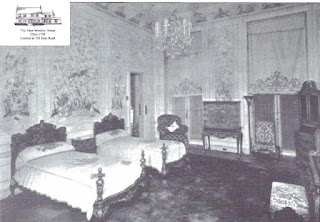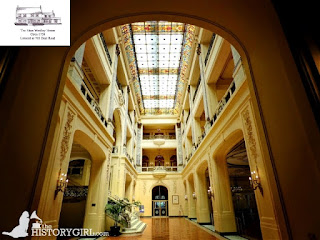West Long Branch Former Sections
Digital interactions for Friends of the
Township of Ocean Historical Museum!
FORMER SECTIONS OF THE TOWNSHIP OF OCEAN
The area today that is known as West Long Branch was historically included in four (4) successive township governments before achieving independence in 1904. Originally part of Shrewsbury Township, it was in the section that was broken off in 1849 to become Ocean Township. It was in the short-lived Lincoln Township in 1867 and was part of Eatontown Township when it broke off in 1873. It has also had a number of names, including 1815, it was named Hoppertown, after New Yorker John Hopper, who purchased the colonial inn; By 1865; it was known as Mechanicsville, because of the large number of residents who practiced that trade; the name was switched to Branchburg to avoid confusion with another New Jersey town also known as Mechanicsville.
The most well known of all structures in West Long Branch is "Shadow Lawn," which is actually the name of two (2) mansions on the same property. The first, a fifty-two (52) room mansion, was built by John McCall, President of the New York Life Insurance Company. It was designed by architect Henry Edward Creiger. This was the house that Woodrow Wilson used as the "Summer White House" during his Presidency. That house, unfortunately, burned down in 1927 and was replaced by the current structure by the property owner, Hubert Templeton Parsons, President of the F.W. Woolworth store chain.
You think our water tower is elaborate, the is their water tower and stables. The stables/old water tower still stands (although not the tower part). Today it is the Joan and Robert Rechnitz Arts Building.
The most well known of all structures in West Long Branch is "Shadow Lawn," which is actually the name of two (2) mansions on the same property. The first, a fifty-two (52) room mansion, was built by John McCall, President of the New York Life Insurance Company. It was designed by architect Henry Edward Creiger. This was the house that Woodrow Wilson used as the "Summer White House" during his Presidency. That house, unfortunately, burned down in 1927 and was replaced by the current structure by the property owner, Hubert Templeton Parsons, President of the F.W. Woolworth store chain.
Murry Guggenheim (1858-1939) was the 3rd son of the Guggenheim family. He was Chairman of the Finance Committee of the Guggenheim Brothers Company's refinery and smelter, was director of the Kennecott Copper company, and, after the death of his brother Daniel, also assumed the Presidency of the family monopoly on quarries of nitrate in Chile. 'Norwood Park', the Murry Guggenheim estate designed by Carrere & Hastings c. 1904 in Elberon, New Jersey. Following Guggenheim's death, the house was willed to Monmouth College and has served as their library since 1961
Adjacent to "Hollywood" and bordered by Norwood Avenue in Eatontown Township was another cottage colony, "Norwood Park", created by Norman L. Munro. He was a successful New York publisher whose country seat, "Normahurst", was located on the northwest corner of Cedar and Norwood Avenue. Norwood Park was developed in the latter part of the 1880s and flourished into the early part of the 1900's It was located just to the west of Hollywood and connected to it either by means of Hollywood Avenue or Cedar Avenue.
Thanks to Robert J. Fischer, George H. Moss Jr, Elsalyn Palmisano, Joann D'Esposito-Wachtmann, Robert VanBenthysen, and Rutgers University Libraries







































































































